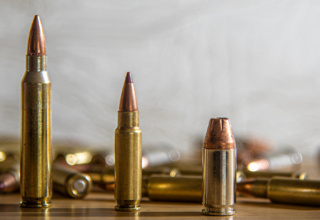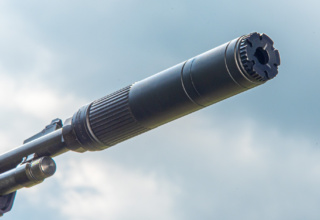The morning was uneventful. Since before daybreak, no sound of turkeys could be heard. I waited patiently to listen for a fly-down cackle, gobbles or anything that would give the resemblance of a turkey. A rustling of leaves here, a squirrel bark there were the only sounds to be heard. Nothing was answering my calls.
 As a bow hunter, nothing pushes my limits more than bow hunting turkeys. Some may say that bow hunting turkeys is easy, and if you use decoys and pop up blinds, it is easy and, in my estimation, anticlimactic. Killing turkeys from pop-up blinds, in the eyes of some, is not the same as hunting them without these aids. As one fellow said, when referring to someone who killed a turkey from a pop-up blind, “You killed a turkey, but you didn’t hunt a turkey.” Having said that, hunting turkeys out of a blind has its advantages, especially when using archery tackle.
As a bow hunter, nothing pushes my limits more than bow hunting turkeys. Some may say that bow hunting turkeys is easy, and if you use decoys and pop up blinds, it is easy and, in my estimation, anticlimactic. Killing turkeys from pop-up blinds, in the eyes of some, is not the same as hunting them without these aids. As one fellow said, when referring to someone who killed a turkey from a pop-up blind, “You killed a turkey, but you didn’t hunt a turkey.” Having said that, hunting turkeys out of a blind has its advantages, especially when using archery tackle.
But as effective as the blind is, it has its limitations. Primarily, there is a lack of flexibility in changing your location. Hunters in blinds are stuck to that one location, whereas hunters who are not using a blind have the option to move and change their setup on a turkey.
Some turkey hunters have said it is impossible to kill a mature turkey with archery equipment while not using some kind of blind to hide the movement. It is indeed difficult, but if you want to experience turkey hunting on a different level, grab your archery gear, and head out hunting turkeys without a blind.
When beginning this quest, one must quickly realize that you may need to adjust your equipment. It is imperative that you have a short bow, something that is around the 31”-33” of axel length. Hunters will often find themselves sitting flat on the ground when the opportunity to draw presents itself. Having a bow that will allow you to draw and not touch the ground is an advantage. Drawing, aiming and shooting with a piece of mind that your bow is clear of obstructions enhances concentration on the shot. With a diminutive axel to axel length, hunters should be able to shoot from any position they find themselves in while turkey hunting.
Another adjustment to your equipment when setting up for archery hunting turkeys is to begin by lowering your bow poundage. The poundage you use for big game is not necessary nor an advantage when hunting turkeys. You will need to be able to draw your bow in one fluid, slow motion, stopping anywhere along that cycle in case you are spotted while drawing. Too many archers overpower their bows and have to contort themselves to get their bows drawn. When it comes to your bow for turkeys, less is more is a good rule of thumb. Bows that are shooting anywhere from forty-five to fifty-five pounds is ample for turkey hunting. A single pin, or at most two pins, set at fifteen and twenty-five yards is all that is needed. Can you shoot farther, sure, but why would you? Your arrows should be a good strong arrow like the Beman Whiteouts. These arrows are perfectly suited for turkey hunting. Similarly, a good broadhead is essential. Whether you choose a mechanical or fixed head, remember that kinetic energy is important. A smaller head will provide deeper penetration with lighter bows.
 Tactics used in hunting turkeys with a bow are the same with a shotgun. The only differences are the equipment used to make the kill. It takes a lot more movement to raise, draw and shoot a bow than a shotgun. This seems to be the nemesis when bow hunting turkeys. Turkeys have extremely keen eyesight. Their ability to detect movement, shapes and colors are on a level different from any other North American game animal. Being able to get a bird into range, draw your bow, aim, shoot and hit your turkey without being detected may just be one of the most difficult tasks to accomplish in the outdoors.
Tactics used in hunting turkeys with a bow are the same with a shotgun. The only differences are the equipment used to make the kill. It takes a lot more movement to raise, draw and shoot a bow than a shotgun. This seems to be the nemesis when bow hunting turkeys. Turkeys have extremely keen eyesight. Their ability to detect movement, shapes and colors are on a level different from any other North American game animal. Being able to get a bird into range, draw your bow, aim, shoot and hit your turkey without being detected may just be one of the most difficult tasks to accomplish in the outdoors.
Turkeys are wild and wary; they never play by the rules, if indeed, there are any rules in turkey hunting. Many hunts have been foiled because the turkey hung up behind a tree and stayed there longer than the hunter could hold the draw. Being able to hold your bow at full draw for a minimum of two full minutes can, in many cases, be the determining factor. When the turkey presents you with an opportunity to draw, you must take it, but it could be several minutes before you are given a good shot or opportunity.
 Being flexible and mobile is another approach when bow hunting for turkeys. As has been said before and will be said again, “Rambling while turkey hunting is often the best strategy.” Often rambling finds hunters still standing when a turkey commits. Rather than scrambling to get a good seat, hiding behind a large tree and continuing to call and get ready to shoot, standing and hiding behind the tree can be a better option. It enables hunters to use the tree as cover to draw the bow, adjust, twist, turn and get ready for the shot more than sitting down allows.
Being flexible and mobile is another approach when bow hunting for turkeys. As has been said before and will be said again, “Rambling while turkey hunting is often the best strategy.” Often rambling finds hunters still standing when a turkey commits. Rather than scrambling to get a good seat, hiding behind a large tree and continuing to call and get ready to shoot, standing and hiding behind the tree can be a better option. It enables hunters to use the tree as cover to draw the bow, adjust, twist, turn and get ready for the shot more than sitting down allows.
Using different strategies, tactics and methods can make your experience chasing turkeys enjoyable. When using archery tackle, the challenge is high and difficult. But when you connect, there is no greater thrill.














